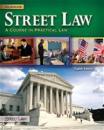To keep up with the issues of the times, Street Law Inc., a nonprofit organization supporting civics education, has added a chapter on immigration law and policy to its new textbook for high school courses in “practical law.”

“Everyone needs to think about what our immigration policy should be,” said Lee Arbetman, the director of U.S. programs for Street Law, in explaining why the 2010 Street Law textbook has included immigration issues.
The organization lines up law students to co-teach classes about the nation’s laws with high school teachers. Typically, the class is taught as an elective. I mention Street Law in a story about civics education that edweek.org published this week.
Along with adding a chapter about immigration to the topics it traditionally has covered over the years and providing law students to help teach about the law, Street Law is also launching a program to provide immigration lawyers or law students to support high school teachers in teaching students about immigration law. The American Immigration Lawyers’ Association and the American Immigration Law Foundation are partners in that effort.
The chapter on immigration law covers such topics as how one becomes a U.S. citizen and the process for seeking asylum. It gives students case studies to discuss to apply their understanding of immigration law.
But I came across a statement in the chapter that didn’t fit with what I’ve learned about immigration law while reporting on English-language learners for EdWeek. Here’s an excerpt:
Minor children (under age 18) born in the United States to parents who are not in the country legally are citizens. However, they can be required to leave the country if their parents are removed or deported so that the family can stay together.
I checked this wording out with Richard Rocha, a spokesman for U.S. Immigration and Customs Enforcement of the U.S. Department of Homeland Security. He said that minors who are born in this country cannot be required by the U.S. government to be deported along with their parents. “They are U.S. citizens. They are legally authorized to be here in the United States.”
If parents who are undocumented are removed from the country, he said, the U.S. government leaves it up to them to decide whether they want to transfer guardianship of their children to someone in the United States or take their children back with them to their country of origin.
I guess one could conclude that statement in the textbook is not wrong in that U.S.-born minors can be required by their parents, though not by the U.S. government, to leave the country. But I think it’s fair to say the statement is misleading.
I conferred with Roger Rice, a lawyer for the Somerville, Mass.-based Multicultural Education, Training, and Advocacy, an organization that advocates for ELLs, on this same issue. He noted that the statement in the textbook “may be written in too stark of a way.” His understanding of the law matched what the spokesman for ICE said.
But he added that textbook writers have a huge challenge in trying to convey immigration law to high school students in a simple, clear way. “Immigration law is incredibly difficult to articulate accurately in a straightforward, simple way,” Rice said.
I’ll say “amen” to that, from what I’ve learned while writing sometimes about immigration issues.
I’ve sent an e-mail message to Arbetman to see if he has anything to add about the statement regarding removal of minors in the textbook, and I’ll update this blog if I hear back from him.